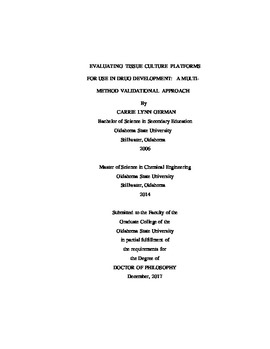| dc.contributor.advisor | Madihally, Sundararajan V. | |
| dc.contributor.author | German, Carrie Lynn | |
| dc.date.accessioned | 2018-06-18T16:02:19Z | |
| dc.date.available | 2018-06-18T16:02:19Z | |
| dc.date.issued | 2017-12 | |
| dc.identifier.uri | https://hdl.handle.net/11244/300057 | |
| dc.description.abstract | There has been significant interest in the development of synthetic tissue constructs for drug screening. Multiple approaches to developing tissue cultures that mimic in vivo conditions have been investigated, including three dimensional (3D) culturing and co-culturing. Little work has been done to develop in silico tools that provide drug pharmacokinetic (PK) profiles that can tie in vitro results to clinical data. In this regard, the possibility of integrating data and models into a 3D computational simulation using acetaminophen (APAP) as a case study was explored. Of particular concern with synthetic tissue constructs is maintenance of cellular functions. Thus, the effect of culturing 2 different hepatic cell lines (HepG2 and HepaRG) in 2D and 3D, using monoculture and co-culturing techniques, on enzyme activity, protein and urea section were investigated. A computational fluid dynamics software (Comsol) was used to create a 3D geometry based on 24-well and 96-well plate configurations. The effects of i) considering a total contribution to metabolism versus individualized contribution for CYP and UGT isoforms, ii) evaluating individualized metabolism based on isoform contributions and abundance, iiI) dosage and cell number, and iv) tissue culture size on APAP metabolism for 24 h were evaluated in silico. Obtained metabolic profiles were compared with the clinical data. APAP-GSH formation was over-predicted when rates of individual CYP isoform kinetics were simulated. When relative contributions of activity of each isoform was incorporated, metabolic distribution agreed with clinical data. Increased APAP content decreased APAP-Sulfation yield. Increased cell number increased APAP conversion and all metabolite yields. Simulation results validated by clinical data were compared with the various culturing systems. Results demonstrated that co-culturing had the greatest effect on PK results, as well as enzyme activity and protein and urea synthesis. | |
| dc.format | application/pdf | |
| dc.language | en_US | |
| dc.rights | Copyright is held by the author who has granted the Oklahoma State University Library the non-exclusive right to share this material in its institutional repository. Contact Digital Library Services at lib-dls@okstate.edu or 405-744-9161 for the permission policy on the use, reproduction or distribution of this material. | |
| dc.title | Evaluating tissue culture platforms for use in drug development: A multi-method validational approach | |
| dc.contributor.committeeMember | Johannes, A. J. | |
| dc.contributor.committeeMember | Ford Versypt, Ashlee | |
| dc.contributor.committeeMember | Pope, Carey N. | |
| osu.filename | German_okstate_0664D_15497.pdf | |
| osu.accesstype | Open Access | |
| dc.type.genre | Dissertation | |
| dc.type.material | Text | |
| thesis.degree.discipline | Chemical Engineering | |
| thesis.degree.grantor | Oklahoma State University | |
